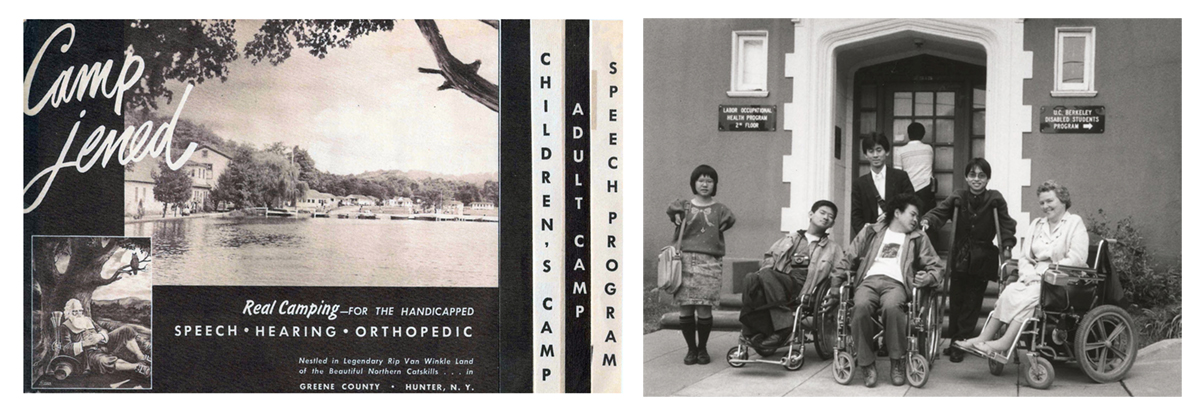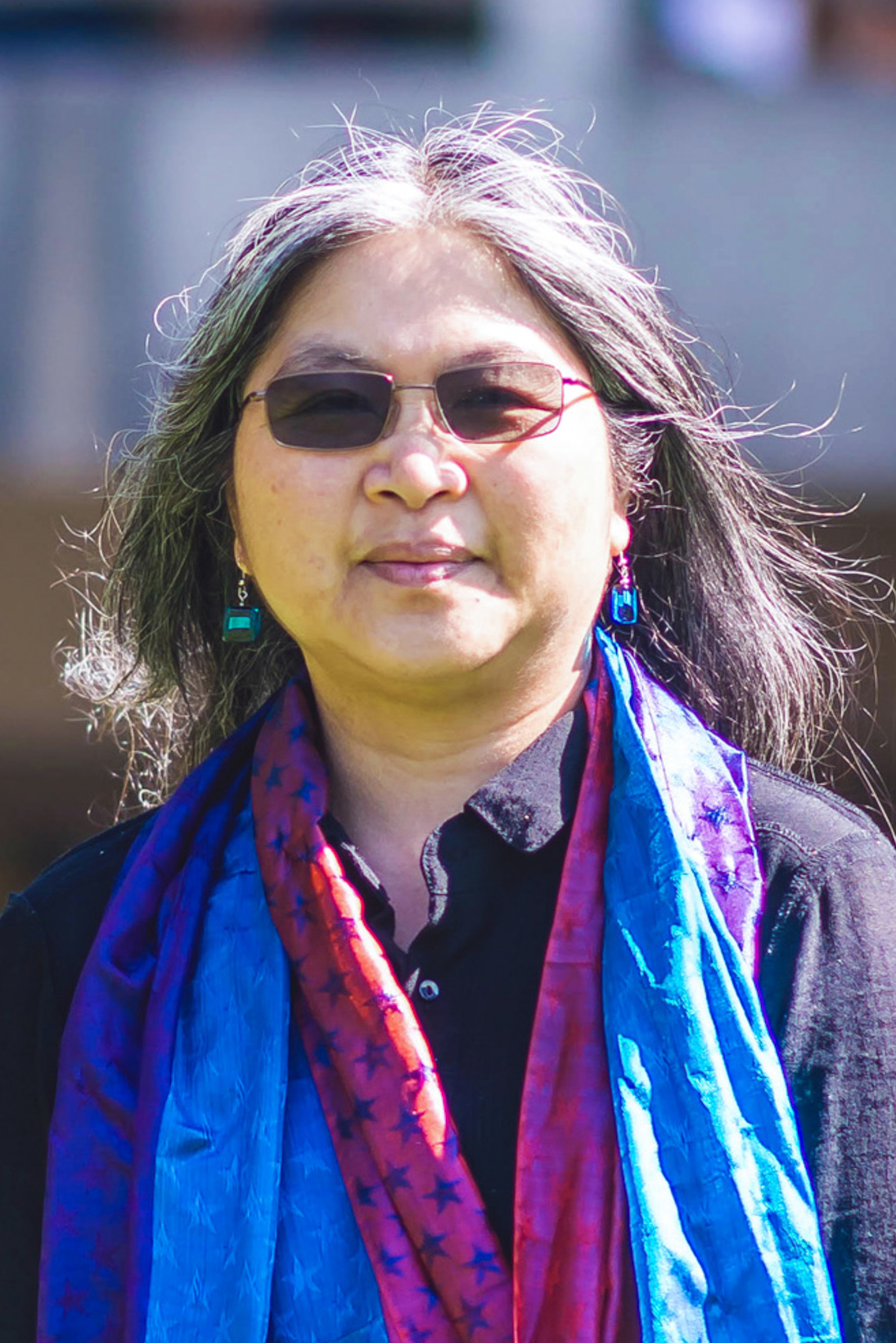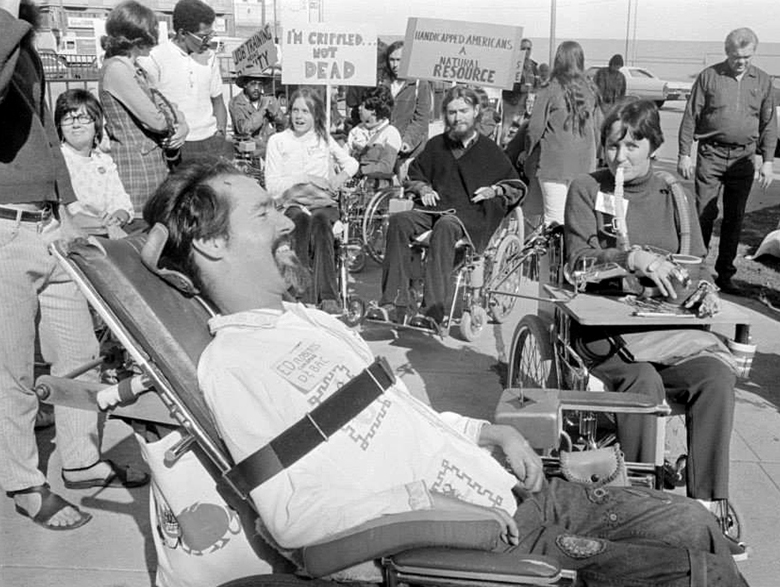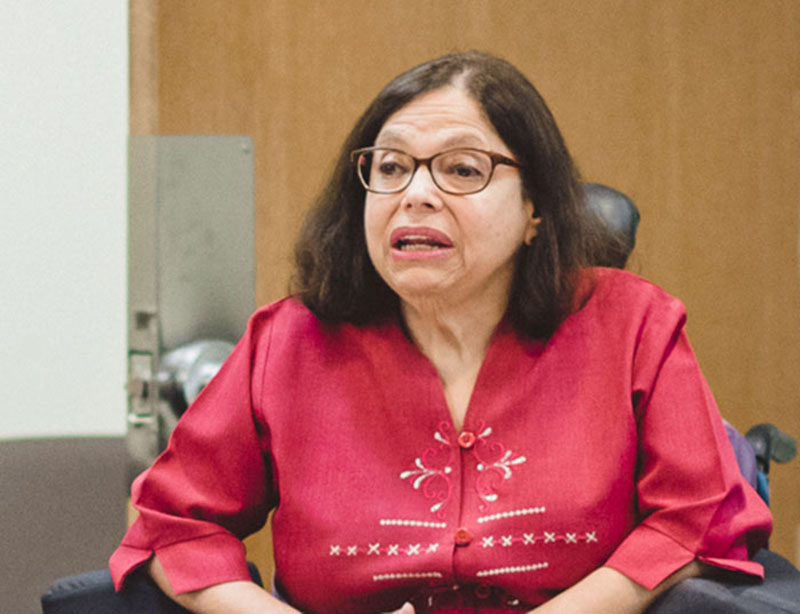
From left to right: A Camp Jened brochure from the 1950s is one of many materials on display. Students pose in front of the University of California, Berkeley’s Disabled Students Programs building with program director Susan O’Hara, at far right. The program was established in 1970. (From left to right: Bancroft Library, Camp Jened Newspaper Archive Collection, BANC MSS 2012/178; University Archives at Bancroft Library, Disabled Students Programs Photo Collection, UARC PIC 28H:209)
Summer camp is a rite of passage for many kids in the United States: swimming, arts and crafts, long bunkhouse conversations and, potentially, priceless memories that will last a lifetime.
For the participants and counselors at Camp Jened, an overnight camp for people with disabilities that originally operated in upstate New York from 1951 to 1977, the experience was much more. Amid the modest buildings and overgrown fields, the young people stumbled upon something revolutionary: a world that was built to embrace them, not ignore them.
That experience of equality, community, and empowerment sparked a revolution. Several Camp Jened graduates became key figures in the U.S. disability rights movement. They led one of the most dramatic civil rights marches in history, fighting for equal treatment under the law and reshaping the nation’s public spaces. Their work ultimately led to the passage of the Americans with Disabilities Act in 1990.
“The amazing thing is, this camp changed the world,” Jim LeBrecht said in the award-winning 2022 documentary Crip Camp: A Disability Revolution, “and nobody knows that story.” LeBrecht and co-director Nicole Newnham, both Camp Jened alumni, tell that incredible story in the film through a series of archival footage.
Crip Camp is this year’s featured piece in UC Berkeley’s On the Same Page program. This popular initiative, held each fall, features works that freshman students can engage with through a variety of programs and events throughout the semester. To complement this selection, UC Berkeley Libraries is presenting an exhibition that expands on the film’s themes and traces the history of the disability rights movement from camp to the UC campus and beyond. “Camp, Campus, and the Disability Revolution” will be on display in Doe Library’s Bernice Lane Brown Gallery beginning September 13. An online version of the exhibition will be available in spring 2024.

Lee
“We wanted to include as many voices from the community and its allies as possible,” says Corliss Lee, American Culture Librarian and exhibit curator, “so you’ll see a lot of citations, from oral histories to selected books, so we can let people speak for themselves.”
Many of the exhibit’s materials were provided by Bancroft Library’s Disability Rights and Independent Living Movement Project. To her surprise, Lee found items from Camp Jened itself in the library’s collection, including original Camp Jened pamphlets, newsletters, and artwork by campers. Most of these items were given to Bancroft by Camp Jened alumna, author and activist Denise Shelagh Jacobson, one of Crip Camp’s main characters and who delivers some of the funniest lines in the film. She also interviewed many of the movement’s leaders for Bancroft’s Oral History Center.
Testimony from the Frontline
The exhibit centers around transcripts of oral histories from various interviewers, including conversations with Ed Roberts (1964, M.A. 1966), the first student with a severe disability to graduate from UC Berkeley and co-founder of the Center for Independent Living. The oral histories are complemented by other first-person sources, including the memoir of Judy Heumann (M.P.H. 1975). A Genned alumna, Heumann is often referred to as the mother of the disability rights movement. Bancroft also preserves the personal papers of Roberts and Heumann.

Ed Roberts (1939-1995) is often called the father of the independent living movement. He was the first severely disabled student at the University of California, earning his bachelor’s degree in 1964 and his master’s in 1966. Initially, Roberts lived at Cowell Hospital because the dorms could not accommodate his 800-pound iron lung (a type of artificial respirator). He and other activists founded the Disabled Students Program in 1970. To help members of their community, they developed the independent living movement. The first independent living center was established in Berkeley in 1972, and Roberts served as its director from 1973 to 1975. (Photo from the San Francisco Examiner Photo Archives at the Bancroft Library, BANC PIC 2006.029:142256.04.33–NEG)
Teresa Salazar, Bancroft Library’s curator of Western American culture, said the exhibit shows the depth of the library’s archival collections, but also documents a movement that emerged from the university. “Many of these people had attended UC Berkeley or were active in the Berkeley independent living movement,” Salazar said. “They went to great lengths to bring their issues and demands to the forefront.”
Protests were one of activists’ most effective tools. The 504 Sit-in is covered in detail in both Crip Camp and the exhibit. On April 5, 1977, more than 500 people rallied outside the San Francisco Federal Building to demand that regulations under Section 504 of the Rehabilitation Act of 1973 be signed into law, which prohibits discrimination against people with disabilities in federally funded programs. That night, 150 people with disabilities and their supporters began a 24-day occupation of the building, a goal that was met.
“We showed strength and courage and power and determination,” Kitty Kohn says in the documentary. “We had been shut away, shut out, hidden, thought to be fragile and weak, but we could take on the highest levels of government and win.”
Cohn, one of the lead organizers of the sit-ins, shared strategies the group used in its advocacy efforts as part of an oral history from the late ’90s, excerpts of which are on display in the exhibit.
Eileen Liu, director of curriculum engagement initiatives in Berkeley’s College of Arts and Sciences, said it’s exciting that UC is involved with such an event. Liu leads the “On the Same Page” program team, guiding the intercampus committee that chose Crip Camp as this year’s flagship activity. (The video is available for free on the program’s website.) Student feedback on the choice has been unanimously positive.
“The students were very proud of this history,” she said. “They were saying things like, ‘I’d never heard of the 504 sit-in. I didn’t know Berkeley was part of this history.'”
Liu added that having students speak about the film’s themes is especially valuable now, as more students with disabilities receive on-campus services.
Campus Community
A large portion of the exhibit is devoted to the history of Berkeley students with disabilities and their work to make the campus more accessible. The origin stories of pioneering organizations such as the Disabled Students Program (DSP), founded in 1970, are told through the words of student leaders. People like Roberts, Cathy Caulfield, and John Hessler (Class of 1966), MA ’70, talk about the challenges and successes of their work.
Exhibit curator Lee was amazed by the many discoveries he made during his research, including being thrilled to find the original application used to set up the Rolling Quadriplegics student program.

Judith Heumann (1947-2023) was known as the “mother of the disability rights movement.” She attended Long Island University and fought to obtain a teaching license in New York State. She and other Camp Genned alumni founded an organization called Disabled In Action. Heumann worked at the Center for Independent Living in Berkeley and later co-founded the World Disability Institute. She served as a special advisor on international disability rights for the U.S. State Department under President Barack Obama. (Photo by Jaron Johns/U.S. Department of State in collaboration with the University of Tennessee Center for Sport, Peace, and Society)
Organization. Dated 1970, the document is signed by group president Herbert Willsmore (Class of 1973) and other leaders. The group was one of the first to lobby the Rehabilitation Department for curb cuts at intersections. Willsmore, whose papers are on file at Bancroft, was also influential in founding the DSP.
For Anne Wai-Yi Kwon ’15, coordinator of the Disability Cultural and Community Center at UC Berkeley, telling these stories is essential. “Every community and movement has elders, and I think it’s important to learn from them,” she says. “(We) recognize the time, effort and hard work that they’ve contributed to the movement, and then think about how we can continue to learn from that great work and build on it.”
Kwon was one of the advisors for the exhibit, consulting on materials and offering suggestions for making the exhibit accessible. The center’s mission is to create a safe and welcoming environment for the disability community, she said, and its comfy couches and multipurpose rooms certainly seem well-suited for community building. Under the umbrella of the broader DSP, the center is one of many campus services for students, staff and faculty with disabilities that are highlighted in the exhibit.
Kwon’s work also involves raising awareness about the fact that ableism still exists on campus and in the off-campus world.
With a remarkable career that took her from camp counselor to special adviser for international disability rights at the U.S. State Department, Heumann knew there would always be work to be done, a job she continued until her death earlier this year.
“I want to see vibrant groups of disabled people all over the world,” she told Crip Camp in her unmistakable New York accent. “And you’re not going to get that if you don’t respect yourself, if you don’t demand what you believe in.”

